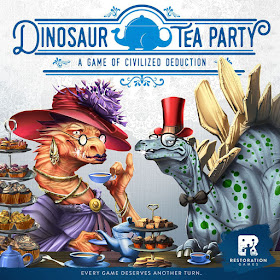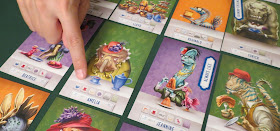I recently got to play an adorable little game. It's designed primarily as a family game, but it's got some depth to it. It's called Dinosaur Tea Party by Restoration Games, and it's a game in which players try to figure out which dapper dinosaurs the other players have in their hands. It's a little like the game Guess Who?, but with some extra mechanics to make it better in all the ways it needs to be better.
Sure, it's not going to satisfy your need for a heavy head-scratcher, but as a light game between bigger ones, or if you want to play a game with some young people that won't leave you completely bored, it's a great option.
Before we get any further into it, let's take a look at the numbers.
Strategy: 1
Randomness: 2
Complexity: 1
Humour: Implicit
Attractiveness: Ideal
Average Length of Game Play: 20 minutes
Gamer Profile Ratings:
Strategy: Low
Conflict: Low
Social Manipulation: Low
Fantasy: Medium
An Overview of Dinosaur Tea Party
The premise of this game is that the players are guests at a tea party to which all the most elegant and well-to-do dinosaurs have been invited, but they can't remember any of the other guests' names, and so are trying to discreetly ask questions that will let them deduce who is who without revealing their socially unacceptable ignorance.
The game consists of two decks of cards. Each deck is made up of the same dinosaurs, with one being normal-sized cards that you can easily hold in your hand, and the other one being oversized cards that can be laid out in the middle of the table for everyone to easily see. Each card depicts a dinosaur dressed in their finest high-tea apparel, sitting at (or on, if it's a small dinosaur) a table engaged in some tea-time activity, such as eating cake or sipping from a teacup.
Additionally, there are a number of tokens representing the fifteen traits that the dinosaurs may possess. There are also three 'quirk' tiles that read 'Always lies,' 'Switches answers,' or 'Always says "no."' And finally, there are plastic 'sugar cubes' that are used as point tokens.
The players each receive one of the small cards, indicating which dinosaur they are. They then take turns asking each other which of the fifteen traits apply to their dinosaurs. For example, you might ask 'Are you wearing a hat?' or 'Are you in the green room?' Whichever player you ask the question must answer with a 'yes' or 'no.' Additionally, they must answer honestly (unless their dinosaur has one of the three special tiles listed above; more on this in a moment).
Once a player has answered your question, you use one of your trait tiles to indicate their response. For example, if you asked Gina, 'Are you eating?' and she answered 'No,' you would flip your 'eating' trait token to the 'no' side and arrange it so that it is pointing at Gina. This way, you (and all the other players at the table) will be able to easily remember that Gina's dinosaur is not eating.
If you think you know which dinosaur a player has, you can take your turn to guess that instead of guessing one of the trait tokens. If you are correct, you get a sugar cube. Sugar cubes represent points; the first player to score three points wins the game.
Permutations of Dinosaur Tea Party
One of the biggest problems of the game Guess Who? is that it's a two-player game. By adding the trait tokens, Dinosaur Tea Party allows for more players. These tokens permit players to more easily remember not only what questions have been asked, but which traits apply to which players. Thus, a game with three to five players has greater dynamics, as well as some level of intrigue. Furthermore, it lets players broaden their questioning; they must now not only decide what question to ask, but to which player they are going to direct that question.
The trait tokens also require players to be more judicious in which questions they ask. Since each player only has one token for each trait, they can only ask that question once. For example, if I ask Fred if he has stripes, then whichever answer he gives, I have now pointed my 'stripes' token at Fred, and cannot ask any other player if they have stripes. Although I will get that token back and can ask about stripes again later if someone guesses which dinosaur is Fred's and he has to draw a new one, until that time, I will have to rely on other players asking about stripes if I want to know that piece of information about anyone else.
The other big problem with Guess Who? is that it can sometimes be subjective. If you were to simply look at the portrait on, say, Lloyd:
...you might find yourself wondering how to answer the question, 'Are you eating?' Yes, there are a lot of cakes in this portrait, but Lloyd himself is not actually shown eating any. His mouth is closed, he is not holding anything. So does he count as 'eating' anything?
Dinosaur Tea Party solves this problem by including icons (the same ones as seen on the trait tokens that players use when asking questions) on their cards (both the large display cards in the centre of the table, and the small ones that are dealt to the players). You can see in Lloyd's card, above, that it has the orange cake icon above his name. Thus, there is no question that, in Lloyd's case, he is indeed eating.
This means that there is never any confusion about how to answer questions, nor if the person answering your question is answering differently than you would have do to differing perception.
The Quirk Tiles
As mentioned above, there are three 'quirk' tiles. When setting up the game, three dinosaurs are chosen to have a quirk. This is done randomly, so it's different every game. One of the quirk tiles are placed on that dinosaur's card in the centre of the table. Thus, if you draw a card for a dinosaur that has one of these tiles, you will not always answer honestly.
If your dinosaur has the 'always lies' tile, then you will simply say the opposite of whatever trait you have. If yours has the 'switches answers' tile, then regardless of what the true answer would be, you say the opposite of how you answered the last question you were asked. In other words, the first time someone asks you a question, you would answer 'yes,' whether it's true or not. The next question would be answered 'no,' again regardless of the veracity of that answer. The third question is answered 'yes,' again, and so on, back and forth between 'yes' and 'no' until someone figures out what you are doing and guesses your dinosaur, causing you to draw a new one. And finally, the dinosaur with the 'always says "no"' tile will always say no to any question, regardless of what they actually have on their card.
This adds an extra level of challenge to the game, and makes it more interesting (especially for older players).
Final Thoughts on Dinosaur Tea Party
This game was really cute. I might not have enjoyed it so much if it weren't for the adorable artwork; seeing slightly anthropomorphised dinosaurs in fancy outfits at a high society tea party is just the right kind of silliness for my taste. Sure, I probably would have enjoyed the game anyway if it had been illustrations of people instead of dinosaurs, but the whimsical nonsense of the premise added just the right level of interest to the game.
But let's not forget about the six characteristics of a good game:
- It ends decisively.
- It allows for upsets.
- It's fun to lose.
- It's relatively simple.
- It has no player elimination.
- It relies on player agency.
I'd say that the 'allows for upsets' is more reliant on the players than the game itself; if you're paying attention, you can work to not give the next player information that would result in them getting points instead of you; if not, or if you're not as good at noticing that sort of thing, then it might be harder to catch up with other players once they have more points than you do. Still, I don't think it's a big enough issue to give the dreaded red X to that characteristic. So I'll leave it as is and say, 'Yes, this game has all six characteristics!'
Overall, the mechanics work, and make it palatable for adults without putting it out of reach of young children. As mentioned previously, it's no replacement for heavy games like Scythe or Twilight Imperium, but it's a fun game as lighter fare between meals, or when you want to play with younger people.
At least, I think it is. You might disagree. But either way, I hope I have provided you enough information to decide for yourself. And with that, I bid you as always a fond




No comments:
Post a Comment
I'll be along soon to make sure your comment isn't spam. Until then, just sit tight! Unless your comment IS spam, in which case, bugger off.
Note: only a member of this blog may post a comment.